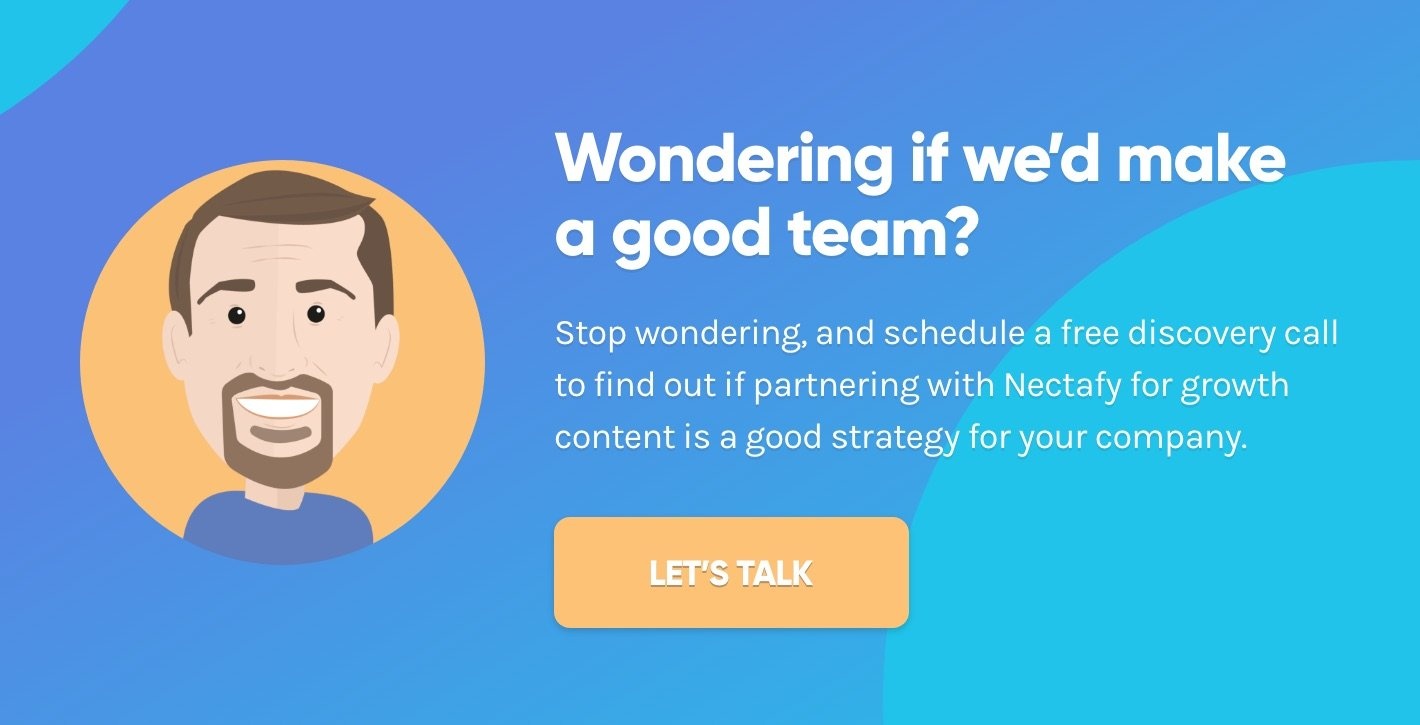How To Write A Revenue-Generating Blog Post: 171 B2B Posts Analyzed



Out on the internet, you’ll see a ton of advice about how to come up with ideas for your business blog. We’ve written those articles ourselves here at Nectafy. Those can be helpful for inspiration, but they miss out on one key point: understanding if your blog posts are bringing in customers and revenue.
After all, the goal of a business blog (like all marketing) is to attract new customers.
In this article, you will learn exactly what goes into a revenue-generating blog post based on real data. We looked at 10 B2B business blogs (Nectafy and nine of our clients) to analyze all of the blog posts that have brought in high-value customers.
Dataset
What did we analyze?
- 10 B2B companies
- 171 unique blog posts, each of which brought in at least one customer (We use HubSpot’s “first page seen” attribute, meaning the first interaction the person had with the company’s website was one of these blog posts and they later closed as a customer.) These posts generated 296 new customers across 10 companies.
What were we trying to find out?
Of blog posts that have been proven to attract real B2B customers…
- What are the titles like?
- What is the average word count (and range of word counts)?
- Which part of the funnel do they target?
- What were the keyword strategies for the top-performing posts?
At the end of this article, we’ll present a data-backed checklist on how to best position your next post to bring in customers.
Titles
What are the trends in these blog titles?
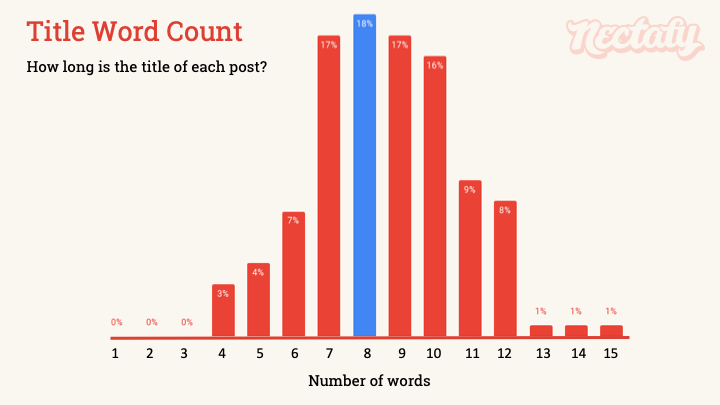
- 100% of the blog post titles have between four and 15 words.
- 95% of the titles have between four and 12 words.
- 68% of the titles have between seven and 10 words.
- The most common length title is eight words (18% of the titles).
Takeaway: Make your blog post title between seven and 10 words.
Question Formats In The Titles
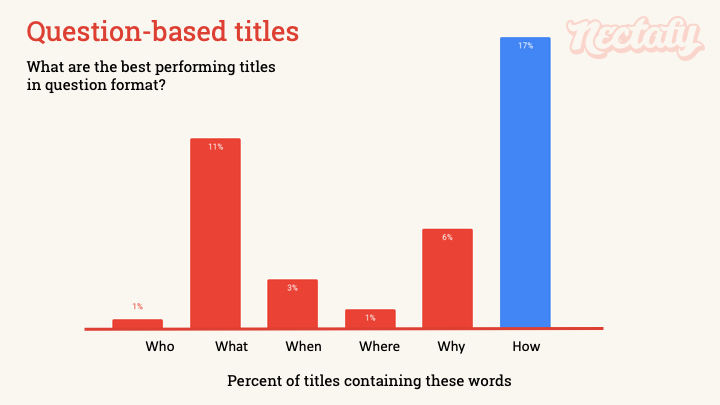
- Out of all 171 blog posts, 66 (39%) contain one of the five Ws or one H.
- “Who” (1%) and “Where” (1%) appear the least in the dataset.
- “How” (17%) is the most common way to form a question-based title.
Takeaway: Consider framing your title in question format. If you do, use “How.”
Most Frequently Used Words
The word cloud below includes the 100 most common words that appear in the blog titles, weighted according to frequency of use. We’ve also removed numbers, and prepositions and determiners like to, of, for, the, a, and in.
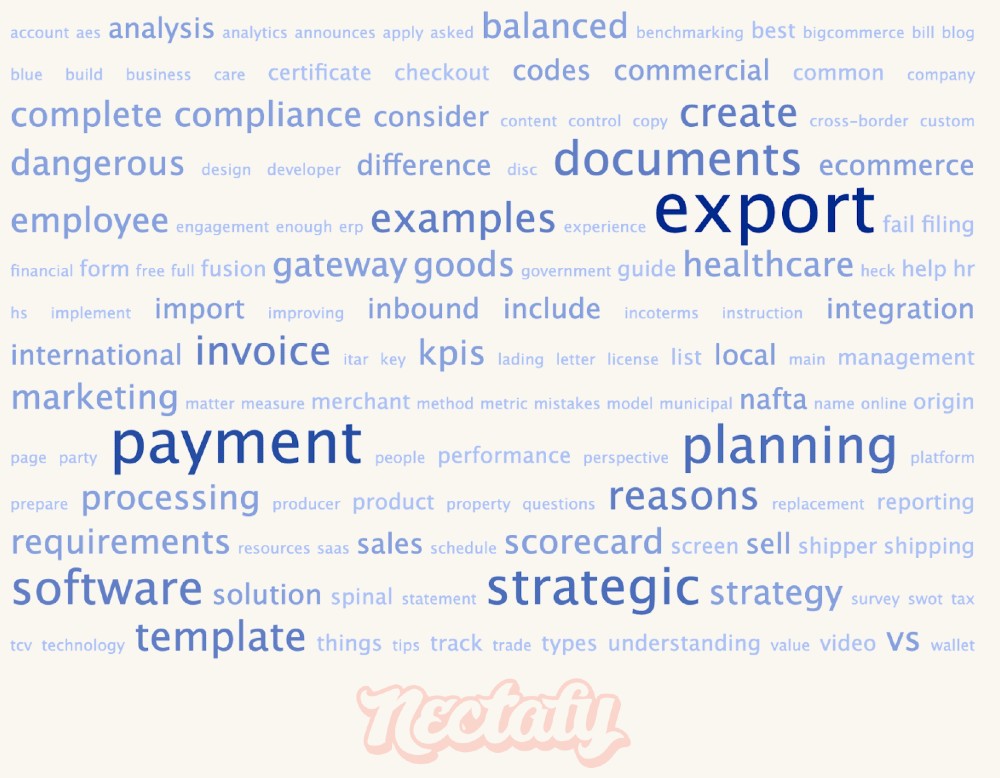
You’ll see a few different categories appear:
- Keywords: The most-used words—like export, payment, planning, compliance, marketing—are essentially the most important word (or keyword) within each of our clients’ industries.
- Industries: You’ll also see words like financial, government, healthcare, international, local, and tax that indicate our clients’ target industries.
- Concepts: Words like software, template, requirements, examples, and analysis can be used across industries and can each be used as a way to format or structure a blog post.
Takeaways:
- Keywords: Go after every long-tail keyword phrase that is applicable to your prospects and keep writing about it. Those words bring in customers and show up a lot in this set. If you sell inbound marketing software, go after inbound marketing examples, tips, techniques, plans, software, ideas, etc.
- Industries: Understand which industries you sell into and write articles specifically for them. You could talk about inbound marketing for SaaS companies, financial companies, companies that sell locally, etc.
- Concepts: Your customers are looking to learn about things in different ways across their research process. Some want to learn about ways to do something themselves (like examples and templates) and others want to find a solution (like software). Write about all of these opportunities that are of interest to your potential customers.
See also: How To Generate $1.1 Million In Sales With Growth Content
Other Title Takeaways
- Think about including a colon in the title (25% of titles contain them). This is a good trick for SEO to put a keyword before the colon, and a hint at what you’ll explain in the article after the colon.
- Think about including a number (31% of titles include them). Please note that this includes years (2019, 2020, etc.) and software releases (10.1, 10.2, etc.).
Article Length
What are the trends in the article word counts?
Body Word Count
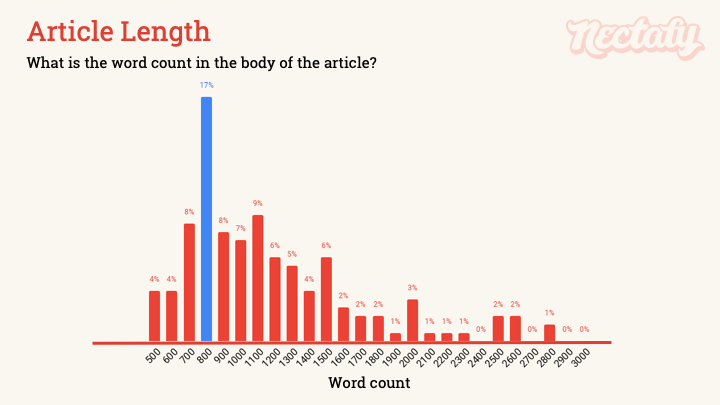
We removed nine outliers from this data set, which accounted for 5% of the blog posts. A few of those had under 100 words because they were videos, and a few others had over 15,000 words (because we’ve gotten crazy before at Nectafy). We also rounded each word count to the closest 100 to consolidate the data.
- 95% of the articles had between 500 and 2,800 words in the article body.
- 68% had between 600 and 1,400 words.
- The most common length title is 800 words (17% of the articles).
There is some bias here, though. A regular blog post that Nectafy delivers is between 600-800 words, so you can see the most articles come in at 800. We also write all different lengths above that, but 600-800 is the most common.
Takeaways:
- Write blog posts of 500 words or more. (It’s hard for your customers to find anything lower than that.)
- If you’re going to write 2,000+ word posts, make sure they focus on an important and high-volume keyword. (Less than 10% of articles that bring in customers are over 2,000 words.)
Stage Of The Funnel
Where in the buyer’s journey do these posts appear?
Your potential customers go through a specific buying process before they choose you as a solution. Referred to as the sales funnel, the process begins with awareness (top of the funnel), then moves to consideration (middle), to decision (bottom). You can write blog posts targeted to each of those three stages to attract prospects wherever they are in their research.
For this study, we tagged each article to a stage of the funnel. It’s a subjective process, but here are the general guidelines we use to mark content by funnel stage:
- Top of funnel (TOF): Any article about trends, comparisons between concepts, how-to’s, definitions, etc.
- Middle of funnel (MOF): Any article about alternatives to certain products, templates, product reviews, step-by-step implementation guides, etc.
- Bottom of funnel (BOF): Any article about a solution you could purchase—software, platforms, services, integration, etc.
Here is where these revenue-generating blog posts fall in the funnel:
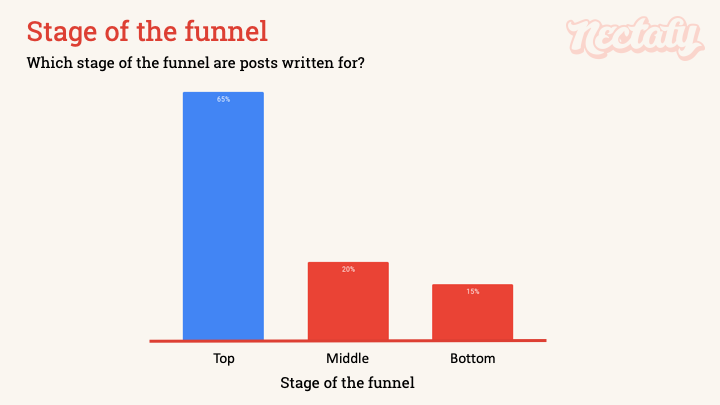
- 65% of the posts come at the top of the funnel.
- 35% come from the middle and bottom.
That doesn’t necessarily mean you should write twice as many TOF posts as MOF and BOF combined. What it most likely means is that there are a lot more searches happening at the top of the funnel than the other phases.
Takeaways:
- You’ll need a lot more visitors going to TOF articles to convert customers than you will at the middle and bottom. Here is a real example for one client:
- A TOF post averages 25,000 visitors per month and has generated four clients.
- A MOF post averages 2,500 visitors per month and has generated four clients.
- A BOF post averages less than 250 visitors per month and has generated four clients.
- Therefore, target bigger topics at the TOF and target just about anything that describes your product at the BOF (no matter how much search volume there is).
- Take a look at these articles to build a content strategy based on your website’s current performance:
- Phase 1: Authority Building—Fewer than 1,000 visits per month and a Domain Authority of less than 20
- Phase 2: Keyword Cultivation—From 1,000–25,000 visits per month and a Domain Authority from 20 to 50
- Phase 3: Sales Growth—Greater than 25,000 visits per month and a Domain Authority from 50 to 100
Analyzing The Top 10 Posts
What do the best of the best have in common?
We analyzed the 10 blog posts that brought in the most customers. These 10 account for only 6% of the dataset, but brought in 14% of the customers. These are the power hitters that bring in new, high-paying customers each and every quarter.
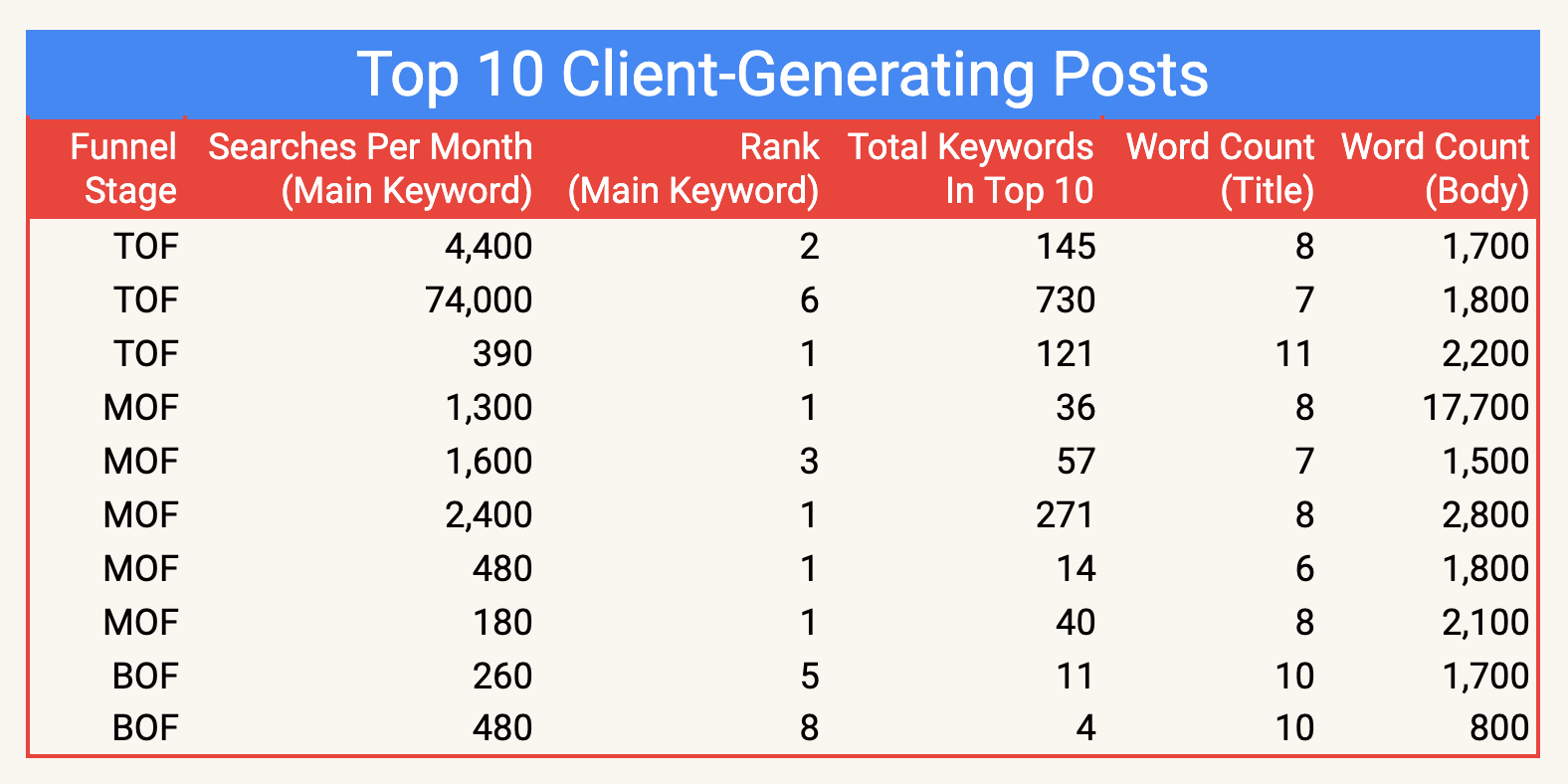
- The 10 posts are spread across stages of the funnel, but commonalities exist in each stage:
- TOF posts (three) have an average of 332 keywords ranking on page one of Google (the top 10 results).
- MOF (five) posts average 84 keywords ranking on page 1.
- BOF (two) posts average eight keywords ranking on page 1.
- The average searches per month in Google for the main keyword targeted is typically…
- In the tens of thousands for TOF posts
- In the thousands for MOF posts
- In the hundreds for BOF posts (or really, any search volume at all)
- All of the articles have a page one ranking for the main keyword targeted.
- All of the titles are between six and 11 words in length.
- All of the articles are at least 800 words.
See also: The Anatomy & ROI Of A One Million-View Blog Post
Takeaways:
- A TOF post needs hundreds of page one keyword rankings and thousands of monthly searches to turn out customers, whereas a BOF post would only need a handful of keyword rankings and a few hundred searches. Have your content strategy line up with those parameters.
- Write titles that are between six and 11 words, and articles that are at least 800 words.
Building The Perfect Client-Generating Blog Post
If you want to write a B2B blog post that attracts high-value B2B clients, the data suggests you follow this checklist:
- Write a title between seven and 10 words, with eight being the best number to target (68% of posts fall in that range).
- If you choose to frame the title in a question format, use “How” (17%).
- Consider including a number in the title (31%).
- Consider including a colon in the title (25%).
- Write articles between 600 and 1,400 words, with 800 words being the best length (68% fall in that range).
- Match keyword search volume with stage of the funnel. Target monthly searches in the tens of thousands for TOF posts, in the thousands for MOF posts, and any search volume at all for BOF posts.
- Make sure you have a chance at ranking on page one for the main keyword you target (and at least a handful of supporting ones), or it won’t bring you customers.
Now, reread my title for this post. How did I do?
If you’d like to learn more about turning your B2B business blog into a lead- and revenue-generating machine, let’s start with a conversation.

